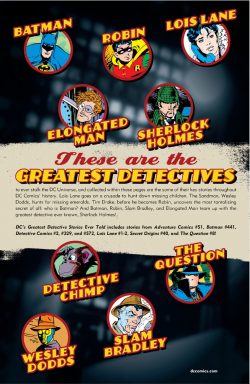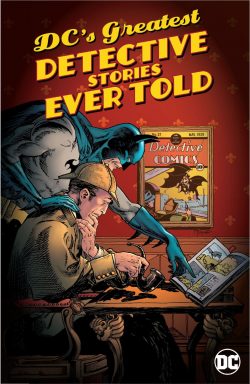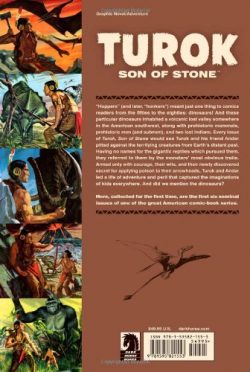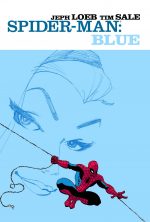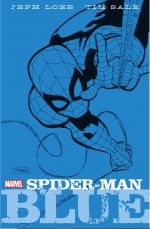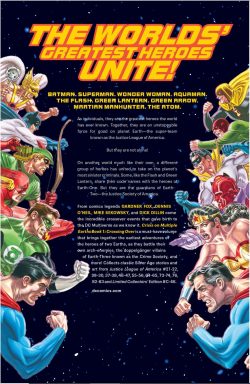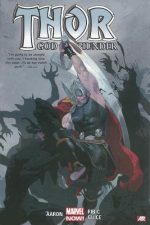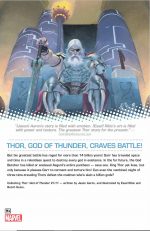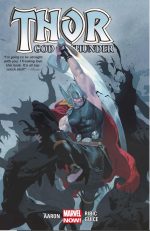
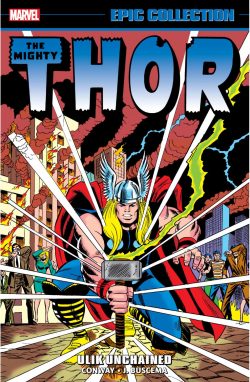
By Gerry Conway, Bill Mantlo, Roy Thomas, John Buscema, Rich Buckler, Sal Buscema, Arvell Jones & Keith Pollard, George Tuska & various (Marvel)
ISBN: 978-1-3029-2949-7 (TPB/Digital edition)
Disabled doctor Donald Blake took a vacation in Norway only to stumble into an alien invasion. Trapped in a cave, he found an ancient walking stick which, when struck against the ground, turned him into the Norse God of Thunder! Within moments he was defending the weak and smiting the wicked.
Months swiftly passed with the Lord of Storms tackling rapacious extraterrestrials, Commie dictators, costumed crazies and cheap thugs, but these soon gave way to a vast kaleidoscope of fantastic worlds and incredible, mythic menaces, usually tackled with an ever-changing cast of stalwart immortal warriors at his side…
As this bombastic compendium (reprinting Mighty Thor #217-241 and Marvel Premier #26 – spanning November 1973 through November 1975) opens, our cosmic cast returns to long-abandoned Asgard after interstellar escapades and bravely endured exile.
Thor #217 sees the triumphant return of Thor with recently rescued from alien enslavement All-Father Odin. He and his fellow heroes Sif, Fandral, Volstagg, Hogun, Hildegarde (plus Rigellian Tana Nile and planetary exile Silas Grant) discover a mysteriously rebuilt Eternal Realm filled with their fellow Asgardians who brandish ‘All Swords Against Them!’
Scripted by Gerry Conway with art by John & Sal Buscema, the saga sees them confronting impossible doppelgangers of Odin, Thor and the rest, all offering murderous hostility…
Whilst the Thunderer furiously struggles to unravel this latest mystery and defeat the invading fakes, in another sector of the universe the all-conquering Colonizers of Rigel are put to flight; abandoning their worlds to an all-consuming force of sheer destruction…
Issue #218 proves there’s no rest for the weary as the again-victorious true Asgardians once more take ship to the stars to prevent the Rigellians’ doom affecting Earth. ‘Where Pass the Black Stars There Also Passes… Death!’ (illustrated by J. Buscema & Jim Mooney) finds the hard-travelling heroes facing a nomadic race of colossal, decadent starfarers who fuel their unending flight by converting thriving civilisations into food and power.
In distant Asgard, war woman Hildegarde’s young sister Krista is slowly falling under the sway of sinister seductive evil, even as her hereditary protectors are a cosmos away, daringly infiltrating one of the Black Stars’ cosmic scoops and encountering a race of mechanical slaves in ‘A Galaxy Consumed!’ (Mike Esposito inks) before they and their charismatic messiah Avalon are at last freed – and untold galaxies subsequently saved – from callous consumption in ‘Behold! The Land of Doom!’
With scripter Conway firmly in the driving seat and legendary illustrator John Buscema (aided by inker Esposito) delivering the art, the mythic mayhem intensifies with ‘Hercules Enraged!’ as Thor savagely attacks Olympus, in search of the Grecian Prince of Power.
After Asgardian maiden’s Krista abduction, the All-Father had a vision of her chained in Hades with the Thunder God’s trusted ally gloating over her beside vile Grecian netherlord Pluto…
By the time lordly Zeus stops the shattering clash that follows, half of the celestial city is in ruins, but in that breathing space he proves Hercules innocent of the atrocious act and the abashed comrades duly turn their attentions to the true culprit…
Inked by Joe Sinnott, Thor #222 finds the earnest comrades in search of Hercules’ insidious impersonator and taking advice from a scary sorceress even as war-god Ares receives an eldritch summons to meet his co-conspirator ‘Before the Gates of Hell!’
Sadly for him, the war god is intercepted by our heroes before he gets there and receives the sound thrashing he deserves prior to the enraged companions storming the netherworld itself. At the moment of their triumph, however, Pluto snatches up his hostage and vanishes. The infernal trail leads straight to Earth where one final confrontation results in ‘Hellfire Across the World!’ (Esposito inks) leaving kidnapped Krista wounded unto death…
After a lengthy hiatus, #224 finds Thor resuming his mortal alter ego as surgeon Don Blake is needed to operate on the dying Asgardian, even as elsewhere in Manhattan, a rash scientist accidentally reactivates Odin’s unstoppable battle construct and discovers ‘No One Can Stop… the Destroyer!’
With Krista saved, Thor joins sorely-pressed Hercules and – although outmatched by the Asgardian killing machine – devises a way to stop its human power source, only to then face ‘The Coming of Firelord!’ (inked by Sinnott). The tempestuous, short-tempered herald of planet-consuming Galactus has been sent to fetch Thor and will brook no refusals…
Issue #226 sees the voracious space god on Earth again, personally beseeching the Thunder God’s aid in ‘The Battle Beyond!’ (Esposito) against living planet Ego, who has seemingly gone mad and now poses a threat to the entire universe…
Deftly channelling Jack Kirby, penciller Rich Buckler (aided by his pals Arvell Jones & Keith Pollard) joined Conway & Sinnott in #227 as the Storm Lord, Hercules and Firelord go ‘In Search of… Ego!’
Penetrating deep within the sentient-but-raving planet and defeating incredible biological horrors acting as planetary antibodies, the trio reach his malfunctioning brain and experience the incredible origin of the “bioverse” in ‘Ego: Beginning and End!’, before contriving an earth-shaking solution to the wild world’s rampages. In a final act of unlikely diplomacy, the Thunderer then finds a replacement herald and secures Firelord’s freedom from Galactus…
Joined by veteran inker Chic Stone, Buckler depicts the godly prince safely back on Earth and facing a new kind of terror in Thor #229 as ‘Where Darkness Dwells, Dwell I!’ finds fellow Avenger Hercules investigating an uncanny string of suicides amongst the mortals of Manhattan. After consulting the Storm Lord and recently returned Sif, the Prince of Power is ambushed by a shadowy figure and himself succumbs to dark despondency…
Plucked from psychological catatonia by Iron Man and recuperating Krista, the severely shaken Hercules recovers enough to lead Thor deep beneath the city where they jointly confront and conquer a horrific lord of fear in #230’s climactic ‘The Sky Above… the Pits Below!’ (inked by Sinnott).
Of greater moment is the revelation in hallowed Asgard that almighty Odin is mysteriously missing again…
John Buscema returned in #231, inked by Dick Giordano to limn ‘A Spectre from the Past!’, wherein Thor learns that former true love Jane Foster is dying: another victim of the recently defeated fear lord. Whilst doting current paramour Sif fruitlessly returns to Asgard seeking a cure, the grieving Thunderer is momentarily distracted when Hercules is attacked by an unbelievably powerful anthropoidal throwback. Disembodied spirit Armak the First Man has somehow possessed the body of an unwary séance attendee and now runs savagely amok in the streets…
Since gaining his liberty, former herald Firelord had been aimlessly travelling the globe. Lured by Asgardian magic he now becomes wicked Loki’s vassal in ‘Lo, the Raging Battle!’…
Heartsick Thor will not leave Jane’s hospital bedside, prompting Sif and Hercules to travel alone to the ends of the universe to retrieve the mystic and fabled Runestaff of Kamo Tharnn. No sooner do they depart than ensorcelled Firelord attacks and whilst incensed, impatient Thor is knocking sense back into him, his evil half-brother leads an Asgardian army in a sneak attack on America…
With ‘Midgard Aflame’ (J. Buscema & Stone) Thor furiously leads the human resistance and learns for the first time that his father is missing. Odin’s faithful vizier reveals the All-Father has deliberately divested himself of his memory and chosen to reside somewhere on Earth as a hapless mortal, the better to learn humility…
With humanity preparing to unleash their atomic arsenal against the occupying Asgardians, the invasion abruptly ends after a savage duel between Thor and Loki in ‘O, Bitter Victory!’ (inked by Sinnott) after which the Thunderer returns to Jane’s side, unaware that he is being stalked by a merciless old enemy. Simultaneously but far, far away Sif and Hercules have clashed with the one ‘Who Lurks Beyond the Labyrinth!’ and secured a remedy for Thor’s mortal beloved…
Thor #236 opens as the Thunder God revels in furious combat with The Absorbing Man. Unknown to the blockbusting battlers, at that very moment Sif is expressing her own love for her wayward prince by using the Runestaff to fix Jane in ‘One Life to Give!’
…And somewhere in California, an imposing old man called Orrin ponders his strangely selective amnesia and wonders how he can possibly possess such incredible strength and vitality…
With combat concluded, Thor hastens back to Jane and finds her completely cured. His joy is short-lived, however, as he realises that Sif is gone, seemingly forever…
Issue #237 finds reunited lovers Don Blake and Jane Foster cautiously getting reacquainted and pondering Sif’s incredible sacrifice when an army of Asgardian Trolls led by ‘Ulik Unchained’ attack New York. Before long, they have made off with Jane under cover of the blockbusting melee that inevitably ensues…
Conway concluded his tenure with Thor #238 as the Thunderer capitulates to his hostage-taking foe and is taken below the worlds of Earth and Asgard on the ‘Night of the Troll!’ Ulik wants to overthrow his king Geirrodur and is confident his hold over his mighty archenemy will accomplish the act for him. He is utterly unprepared for the new martial spirit which now infuses his formerly frail mortal hostage…
…And in California old man Orrin decides to use his power to help the poor, arousing the ire of big business, brutal strike-breakers and the local authorities…
Writer/Editor Roy Thomas and artist Sal Buscema join Sinnott in Thor #239 as the Thunder God brutally ends his association with the trolls even as Orrin’s rabble-rousing civil unrest is cut short when a colossal pyramid containing Egyptian gods erupts from the Californian ground in ‘Time-Quake!’
Thor knows nothing of the latest upheaval. He has returned to Asgard, uncovering a mysterious force draining his people of power and vitality. Warned by duplicitous seer Mimir, the anguished godling rushes back to Earth to clash with puissant Horus ‘When the Gods Make War!’ (Thomas, Bill Mantlo, Sal B & Klaus Janson).
The depleted Egyptian pantheon have desperate need of an All-Father and have conditioned Odin/Orrin to believe that he is their long-lost patron Atum-Re…
Go-getting, proactively take-charge Jane is already waiting in California when Thor arrives and is present when the elder deity devastatingly assaults his astounded son. Happily, her cool head prevails and soon the warring deities are talking. An uneasy alliance forms and the truth comes out. Horus, Isis and Osiris are at war with vile Death God Seth and need the power of a supreme over-god to assure victory for the forces of Life. Sadly, that energy is being siphoned from Asgard…
The cosmic conflict concludes in #241 as ‘The Death-Ship Sails the Stars!’ (Mantlo, John B & Sinnott) with ghastly Seth and his demonic servants ultimately repulsed and Jane again playing a major role: even triumphally shaking Odin out of his compliant, mind-wiped state…
To Be Continued…
Adding lustre next is the cover to all-reprint Giant-Size Thor #1, followed by a compelling contemporaneous solo tale of Hercules (November 1975), taken from Marvel Premiere #26. Used to set up his major role in forthcoming team title The Champions, it was crafted by Mantlo, George Tuska & Vince Colletta. Sporting a new Kirby cover, ‘The Game of Raging Gods’ has the legendary hero relocate to California on the college lecture circuit and targeted by old enemies Typhon the Titan and spurned priestess Cylla the Witch of Delphos…
With covers by John Romita, Buckler, Sinnott, John Buscema, Gil Kane, Esposito, Frank Giacoia, Marie Severin, Tom Palmer, Giordano, Dan Adkins, Klaus Janson and Jack Kirby & Vince Colletta, this collection also includes assorted House ads; covers created by Romita, a John Buscema double page pin-up of the Asgardian cast and a frontispiece by Marie Severin from the Thor-starring reprint edition Marvel Treasury Edition #3.
Thor is one of modern comics’ greatest attractions and a cornerstone of the Marvel Universe. Always a high-point in graphic fantasy, his longevity is all the more impressive for the sheer imagination and timeless readability of the tales crafted by an army of creators. This chronicle is an absolute must for all fans of the medium and far-flung fantasy thrills.
© 2021 MARVEL


